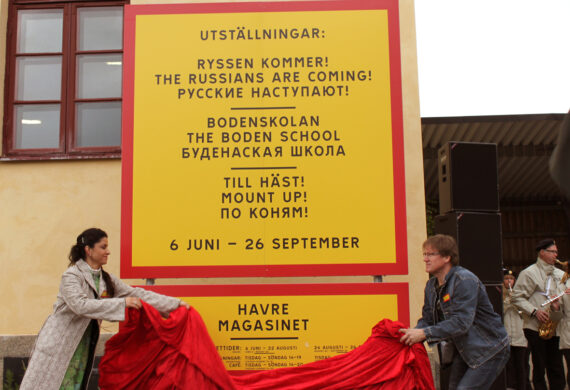
The hopper
The grains arrived by train, loaded in bags of 100 kilos. It was hard work to empty the wagons. First, the sacks were wheeled out and cut open. Then workers unloaded the grains into the hopper.
The building of Havremagasinet is part of Boden’s military history. After Sweden’s war with Russia in 1808, Finland became part of the Russian Empire, which moved the Swedish-Russian border to the Tornio River. Sweden’s era as a great power were long over, and Sweden looked for a new defense strategy. The solution was to build a fortress in Boden to protect the country against an invasion from the east. However, the construction of Boden Fortress would take until the turn of the century.
This building for oat storage ´was part of Boden’s garrison, and its construction completed in 1914. Its purpose was to store oats and grain for military horses. However, both the oat warehouse and the fortress were soon to become obsolete. Motor vehicles and caterpillar feet replaced the horses, and the fortifications were no longer useful. Nevertheless, the warehouse continued to store grain until 1971, and Boden continued to be a crucial area in defense strategy.


Until 1997 there were signs on all roads leading into the city forbidding foreign citizens to enter Boden. It is from this signage that Havremagasinet länskonsthall Boden has borrowed its logo. In the light of a new era and historical change, the first exhibition at Havremagasinet was titled “The Russians are coming.” The year was 2010, and Boden’s role as a military lock towards the East was over. The door to the world was open!
The oats warehouse became one of Sweden’s most prominent public art galleries and has since been showing international contemporary art that deals with topical themes relating to democracy, human rights, and freedom of expression. Despite foreign visitors’ restrictions, Boden has always been in close contact with the outside world through its role in the Swedish defense strategy. The town grew around the fortresses, regiments had recruits from all over the country, and the town’s movements reflected what was happening in the world. It is still the case as today, Boden welcomes new residents from all over the world who have fled conflict zones.
Havremagasinet is a stone building in typical Swedish neoclassicism designed by Erik Josephsson. Supporting the building’s six floors are a total of 288 wooden columns that dominate the interior. Havremagasinet was the storage that would supply oats to all the units in Upper Norrland. Later, the warehouse would also provide the defense mill with wheat and rye for bread. This activity ceased in 1971.
Havremagasinet preserved a historic room where former operations and machinery are still on display and can be visited on level 5A during the summer. And even today, when the temperature and humidity cause the building to adjust, a slight oat rain can come from the ceiling throughout the art hall.
The grains arrived by train, loaded in bags of 100 kilos. It was hard work to empty the wagons. First, the sacks were wheeled out and cut open. Then workers unloaded the grains into the hopper.
From the hopper at the bottom of the warehouse, the machinery then took over and lifted the oats to the hay house via a conveyor belt of shovels. Finally, large metal screw pumps distributed the grains over the entire floor.
The oat warehouse had an ingenious system of elevators, pipes, and containers to move the grains mechanically throughout the warehouse. It was very dusty, and large dust filters were therefore necessary. The warehouse could hold almost 2000 tonnes of grains, and the building was also equipped with a cleaner and scales.
An automatic temperature gauge warned when the temperature of the grains rose above 20 degrees. Then, the grains were set in motion and released on the floor below via hatches and pipes to prevent mold. When it finally reached the ground floor, it was time to transport it back up in a continuous circulation. As a result, the durability of the grains increased as they dried.



